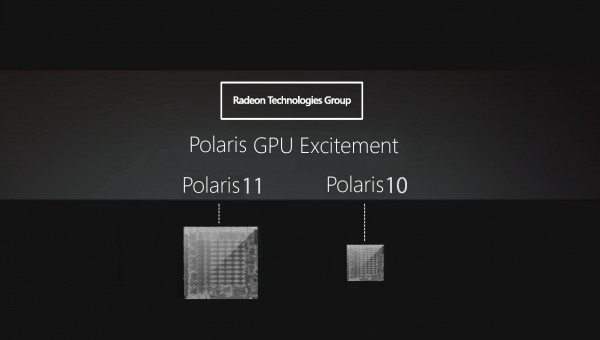While things are quiet at the moment on the Vega front, it looks like news is leaking out about Polaris 10 and Polaris 11 revisions from AMD. The new efficiency focussed GPUs launched earlier this year in the form of the RX 480, 470 and 460 but according to reports this week, AMD may have been able to increase performance per watt even further, paving the way for a potential RX 485, 475 or 465.
According to wccftech's sources, AMD is apparently due to roll out higher performance per watt revisions of its Polaris 10 and Polaris 11 GPUs to the embedded market soon, bringing down the RX 480 from its 150W TDP to around 95W. Similarly the GPU used for the RX 470 and RX 460 may have been revised to run at just 50W instead of 75W.
This has led to speculation that perhaps we will see Polaris revisions in 2017, with an RX 485, RX 475 or RX 465 as part of a GPU refresh. This would be similar to when AMD refreshed the R9 280x and introduced an R9 285.
Unfortunately not much else is known at this time and there isn't a lot of evidence to back these reports up, so take it with a grain of salt. After all, AMD still needs to get its high-end Vega GPUs out before refreshing its mid-range lineup.
KitGuru Says: There has been rumours of Nvidia potentially refreshing Pascal as well next year, so a Polaris refresh doesn't sound too far out there. That said, it would be nice to get more news on Vega first, which is still scheduled to launch in the first half of 2017.
 KitGuru KitGuru.net – Tech News | Hardware News | Hardware Reviews | IOS | Mobile | Gaming | Graphics Cards
KitGuru KitGuru.net – Tech News | Hardware News | Hardware Reviews | IOS | Mobile | Gaming | Graphics Cards




They need to get Vega out before worrying about any farther Polaris refreshes. At the rate they are going Nvidia will have a refresh of Pascal released and put AMD even farther down the food chain. We need AMD to at least try to put up a fight so maybe Nvidia will have to lower their prices farther.
” … according to reports this week, AMD may have been able to reduce performance per watt”
Surely you mean INCREASE performance per watt in the article? They’d hardly make it worse. 😉
Anything is possible 🙂
I want GTX1080 level performance for $399. Preferably from AMD to go with my Freesync monitor.
Let’s say AMD has boosted the perf/Watt of just the GPU, that doesn’t automatically reflect as a massive power reduction for the WHOLE graphics card because there is more circuitry than just the GPU.
In all probability, considering the debut prices of Hawaii and Fiji, $400 will take a few months to dip.
Don’t get me wrong, I wouldn’t mind either as I unknowingly purchased a Freesync monitor; it wasn’t on the HP website when I got it, but says so on the HP Envy 32 itself. While even an RX-480 is three times faster than my last graphics card, I wouldn’t mind Vega.
But I’m thinking the flagship will debut at over $550, a cut-down could be cheaper while another Nano would be the same price as the flagship.
If this is true, that Polaris will be the go-to GPU for laptops. If Vega shares the same process, then Vega will technically be a beast. Now hopefully AMD does something soon cos all this speculation is useless without an actual product release
“Similarly the GPU used for the RX 470 and RX 460 may have been revised to run at just 50W instead of 75W.”
The GPU in the RX470 is Polaris 10 and the one in the 460 is Polaris 11.
That’s grasping at straws a bit. The GPU is probably 90% of the power consumption on mid range cards and more on high end.
Assuming thia is all correct this is great leap for amd making theae cards very efficient
You want the currently impossible. For 600$-ish, maybe (+/- 50$) but 400, nah.
In which case, the RX470 would have a TDP of about 50-75W, and RX460 might go down to 25-35W?
Not by a mile, even on a high-end card like from the nVidia’s Titans, the GPU is less that 50%.
Just go into GPUZ or whatever utility you use for reading off the GPU voltage (VDDC) and GPU current (VDDC Current), and multiply the numbers together, you get the exact number of Watts that just the die uses (barring constantly varying frequencies). We can go back to the Kepler era and see that the GK104 in GTX680 uses around 90W versus the whole card at 185W.
I see they have corrected it now. 🙂
Yes and likely why we are hearing rumours that Apple will use them in the next Macbook.
So what, according to your theory, uses 95W on a GTX680? (be specific please).
Bear in mind that more or less the same circuitry features on e.g. the GTX660, so according to your theory, that GPU would have to use something like 40W to fit inside the overall board power usage. I don’t think so.
“This would be similar to when AMD refreshed the R9 280x and introduced an R9 285.”
Er… not really… 280X was Tahiti, i.e. rebranded 7970 GHZ Edition. 285 was the first iteration of Tonga.
This would be more similar to when AMD refreshed the R9-285 as the R9-380, or the R9-290 as the R9-390. Except in this case, it is my suspicion (not prediction) that these refreshed Polaris chips might become lower-end RX-500 series cards. As a spitballed example:
Big Vega -> RX 590
Little Vega -> RX 580
Refreshed Polaris 10 (480) -> RX 570
Refreshed Polaris 10 (470) -> RX 560
Refreshed Polaris 11 (460) -> RX 550
You picked a perfect example, it is just algebra from here.
The GTX660 has 980-CUDA at 960MHz base against the GTX680 with 1536-CUDA at 1006MHz, so the difference between mathematically makes GTX660 60% of GTX680 in terms of assuming performance and power are porportional at that scale for just their GPUs. All I did was multiply the Cuda and clock of one and divided by the Cuda-clock of the other.
The official spec of both cards is 195W versus 140W, a difference of 45W which represents the 40% cut due to a lesser GPU, since their memory interfaces and bandwidth values are identical (although ref PCBs aren’t identical, lets assume they are). So 45W divided by 0.40 and we get 112W for the GTX680 die at 1006MHz and the GTX660 die at 960MHz turns out to be 67W.
So I retract my previous statement, it is higher than the 50% I theorized, but no where near the 90% you figured. If we scale further up to the first Titan with 2688-CUDA at 837MHz, that means out of the 250W card, the GK110 used 163W at stock base clocks, or 65% of the whole card.
Assuming this method is reasonable (which is a bit of a reach), that’s actually a 55W difference –> 137.5W for the GPU on the 680 and 82.5W for the 660, i.e. 71% of power to the GPU on the 680. But the typical board power of the card is actually 175W and I think I read (but can’t find it now) that typical board power of the 660 is 120W. Now we still have 137.5W GPU power for the 680, but it’s 79% of typical board power consumption.
If this is true then it bodes well for AMD as they have lagged behind Nvidia on efficiency for years now. It could also give some insight into what the the new Xbox will have in it.
My total system power while gaming is about 200 watts average with my ITX motherboard, i5-2500/ GTX 660Ti(150 W TDP), 1ssd, 1 HD, 5 usb devices, 8gb ram( 2 4gb sticks), one system fan. So most likely my gpu is only using 100 watts. Correct?
The revised version of Polaris was certain, given the previously leaked slides. But I’d expected only small increase in performance alongside the power consumption. The lowered TDP from 150W to around 90W is a significant margin and it’s a huge slap for current RX480 card owners.
maybe with this better efficiency they will drive the clock speed of the chip a bit higher and maybe match the fury nano now stock. If they are going to do a dual polaris it would be water cooled so maybe they could even get it to fury x performance ??? idk.
I think my 390x matches a nano at stock speeds if I remember correctly from benches. Now take the same card run it at 1376Mhz Like I am it comes very very close to or matches a Fury X. But I do agree if they could get Fury X performance from only 95 W or even 120 w that would be a huge jump for AMD for sure.
I always thought the RX 480 could have been a great card if it had a few more resources under the hood. It needs more ROP’s 64 and at least 2560 cores and either 256 bit GDDRX5 or 384 Bit GDDR5 and at least 1350-1400Mhz. This would have given the card enough horse power to trump the 390 series for performance and match the Fury Series and even maybe come closer the the Geforce 1070 cards and if priced right they would have had another Radeon HD 4870 type card that sold like hot cakes back then.
They tried to go for a market that was already covered by so many cards. I see their reasoning try to sell to a market at a lower price and give just good enough performance to maybe play at 1080p. The problem was and is They needed something to get the Fury series out of the market those chips were over priced and use way to much power for the performance you get from them those cards needed to disappear form the market asap.
If they would have released the RX 480 with the specs I stated above I most likely would have bought two of them to replace my 2 390x cards that use way to much power but at least they give great 1440p and even 4k performance when the game engine properly supports cross fire. But the RX 480 as it stands is pretty much useless to me.